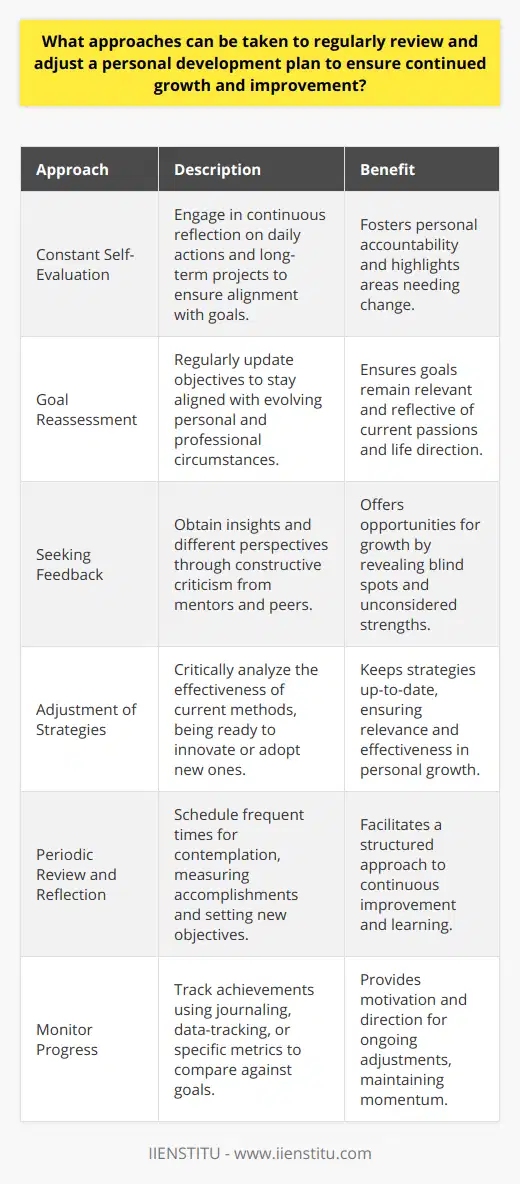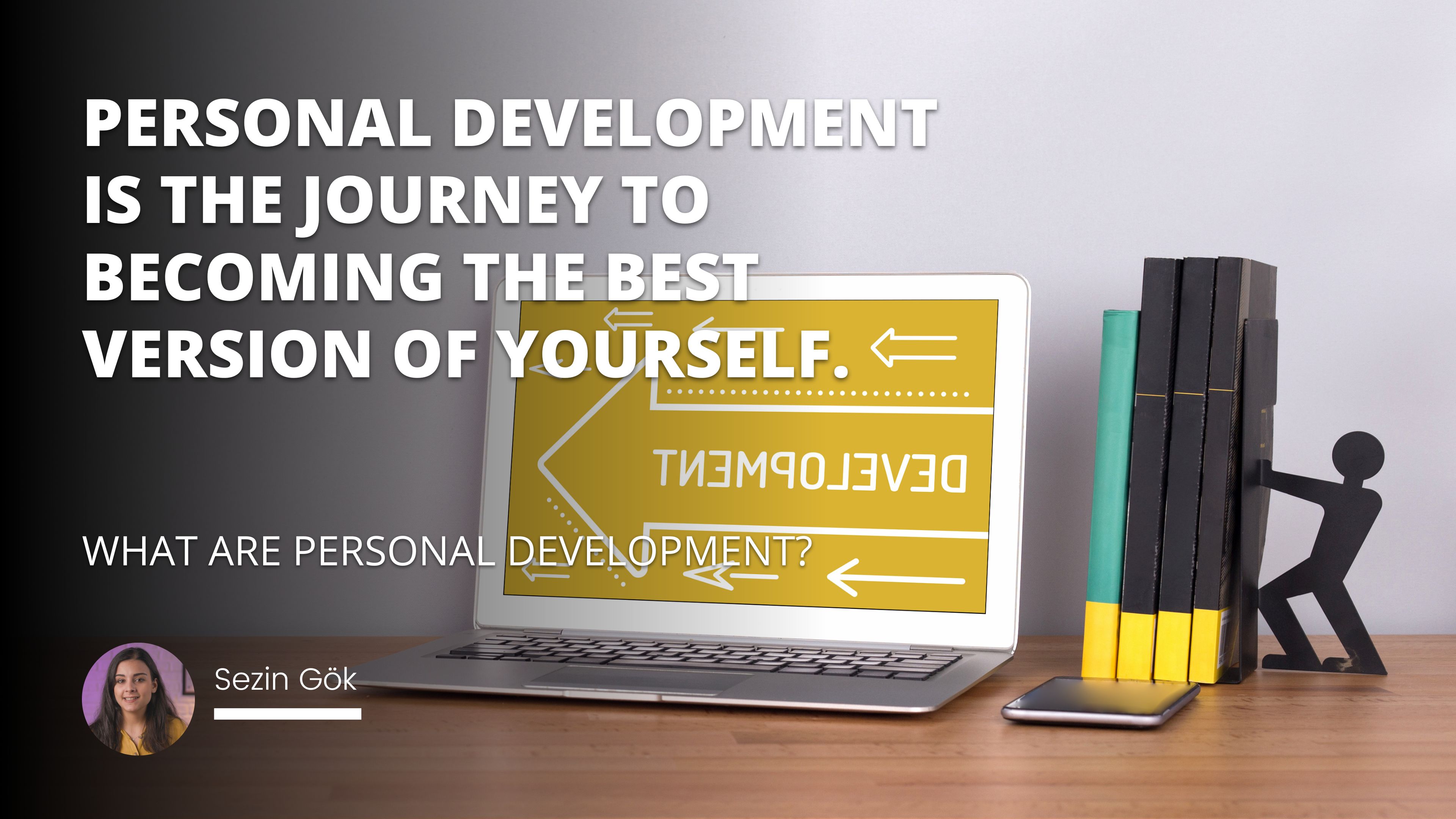
Like most people, you've probably made some New Year's resolutions for 2023. You may have even vowed to get in shape or save more money finally. But have you thought about your personal development? If not, it's time to start planning!
This blog post will discuss the steps necessary to create a personal development plan for 2023. We'll also discuss some of the best online personal development courses and programs. So whether you're looking to improve your communication skills or learn how to manage your time better, there is something here for everyone!
Crafting the Perfect Personal Development Plan: Your Guide to Reaching Your Goals in 2023
It's 2023, and you've achieved your dream. You planned out exactly what you wanted to be, do, and have over the past decade and made it all come true. But how did you do it?
It starts with crafting a successful personal development plan for yourself that focuses on reaching your goals by 2023. In this blog post, we'll discuss the essential steps to creating an effective strategy for personal growth and give you some practical tips for bringing it (and all of your dreams) to fruition!
Related article: What Are Personal Development Plans?
Step 1: Setting clear goals for yourself.
The first step to creating a successful personal development plan is setting clear goals for yourself. For example, what do you want to achieve by 2023?
To achieve success, you need to have a goal to strive for. With a plan, you'll know if you've accomplished anything. When it comes to personal development, it's essential to set clear goals and plan how to achieve them.
Some reasonable goals to have in mind are becoming more confident or improving your relationships. But these goals must be realistic and achievable. Otherwise, you'll only be setting yourself up for disappointment.
Related course: NLP Course
Step 2: Create a plan on how you will achieve them.
Once you've chosen your goals, the next step is to create a plan on how you're going to achieve them. This will involve figuring out what steps to take and when to take them. Set some deadlines so that you're held accountable and can track your progress.
Related course: Time Management Course
If you need help with any steps in achieving your goals, feel free to ask for help from others. There are plenty of people who are more than happy to offer their advice and support. Just be sure to stay focused and stay motivated to reach your final destination!
Once you have your goals in mind, you need to devise a strategy for how you will reach them. This means figuring out the steps you need to take and the tasks you need to complete to get there.
Knowing where to start when it comes to goal setting can be challenging, but breaking it down into smaller steps can make the process easier.
To start, you need to figure out what you want to achieve and devise a plan for how you will do it. Once you have your goals in mind, you need to create a strategy for how you will reach them. This means figuring out the steps you need to take and the tasks you need to complete to get there.
Creating a roadmap for yourself can make the process more manageable and keep you on track. So, if you're looking to make some changes in your life, start by setting some goals and coming up with a plan of action. And remember to celebrate your accomplishments along the way!
Step 3: Create a timeline for your goals.
Next, creating a timeline for your goals is essential as making sure that each step is mapped out with specific deadlines. This will help keep you accountable and ensure that you're making progress toward your targets.
Creating a timeline for your goals is essential to ensure each step is mapped out with specific deadlines. This will help keep you accountable and ensure that you're making progress toward your targets.
The first step is to develop realistic goals you can accomplish in a set amount of time.
Then, once you have your goals, it's essential to break them down into smaller steps to track your progress and ensure you're on track. You'll also want to set specific deadlines for each step so you stay focused and focused.
Finally, staying motivated and focused throughout the process is essential by reminding yourself why you're working towards these goals in the first place.
Related course: Stress Management
Step 4: Stay on track for your personal development goals.
To stay on track, it's essential to have a support system in place. Make sure you have people who can help motivate and encourage you as you work towards your goals.
One of the best ways to stay on track and achieve your goals is to have a support system. This means having people who can help motivate and encourage you as you work towards your goals. These people can be friends, family members, or even professionals such as personal trainers or nutritionists.
It's essential to find people who will be supportive and positive rather than those who will constantly try to discourage you. When you have a support system, staying motivated and focused on your goals is more accessible. In addition, you can rely on your supporters to help keep you on track when things get tough, and they can encourage you when you need it most.
If you still need a support system, building one is always possible. Reach out to the people in your life whom you think would be willing and able to help you, and ask them for their support. You may be surprised at how helpful they are to help!
Step 5: Celebrate your successes along the way!
Finally, be sure to celebrate your successes along the way! Take time to reflect on all you've accomplished and enjoy the journey towards reaching your dreams.
The journey toward reaching one's dreams can be long and arduous, but it is worth it in the end. There are many things to celebrate along the way, such as the small steps you take each day toward your goal. Every victory, no matter how small, should be savored and appreciated.
It is also essential to stay positive and motivated throughout the process. This can sometimes be challenging, but keeping your eyes on the prize is necessary. Remember why you decided to pursue your dream first, and use that as motivation when things get tough.
Finally, remember to enjoy the journey itself. The journey is just as important as the destination, making the trip memorable. Take time to reflect on all that you've accomplished and enjoy the ride as you continue towards reaching your dreams.
Join personal development courses to reach out to your goals!
Goal setting is an essential first step in any personal development plan, but it's only the beginning. Once you set your sights on what you want to achieve, it's time to start planning how you will get there. This means mapping out the steps you need to take and putting together a timeline for yourself. It's also essential to have a support system to stay motivated and on track.
As you work towards your goals, celebrate your successes along the way! When it comes to personal development, goal setting is just the beginning. Join personal development courses at IIENSTITU today and learn more about creating a successful plan for reaching your dreams. Stay on track and reach your dreams with these essential steps for goal setting.
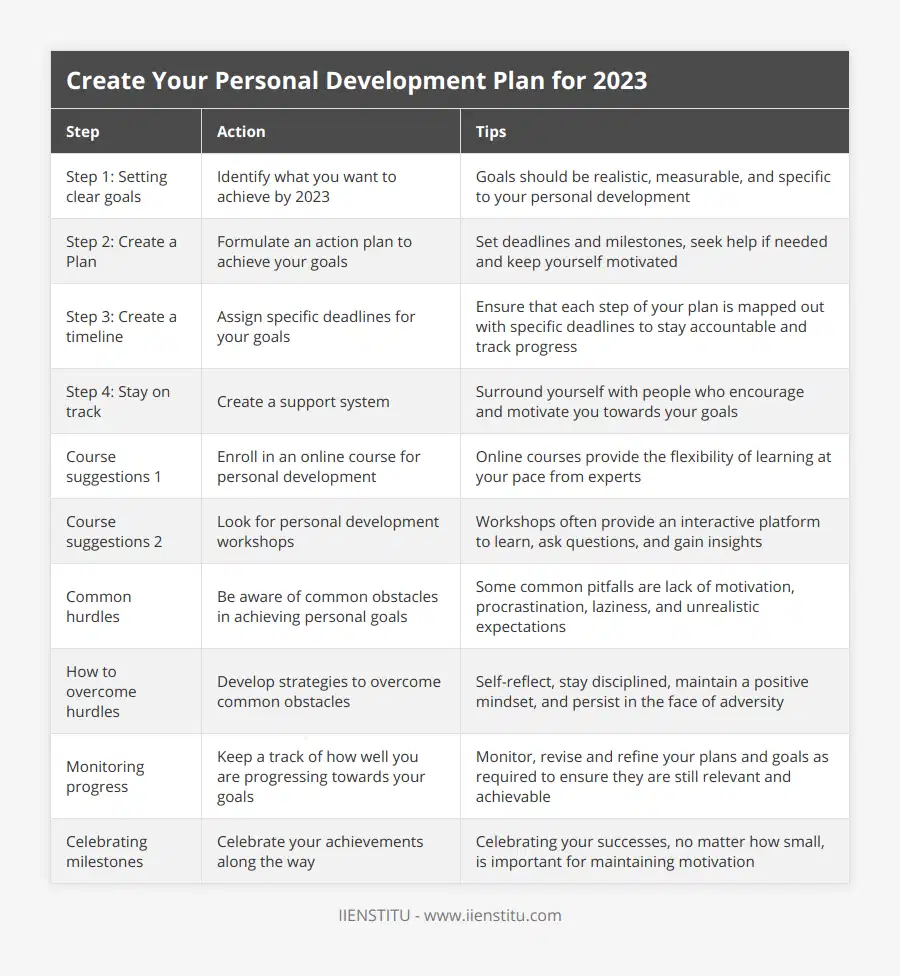
Frequently Asked Questions
How can I create a timeline for my goals?
Creating a timeline for your goals involves mapping out the steps you need to take to reach your desired outcome.
First, start with identifying what needs to be done and break it down into smaller, achievable tasks. Then set a timeline for reaching each milestone and determine when you'll review and adjust if necessary.
Make sure to add some buffer time as well, just in case of delays or setbacks. Additionally, it's essential to stay flexible as plans can change along the way - having a program that allows room for adjustments is critical! With goal setting comes responsibility, but following through is worth the effort and will help ensure success!
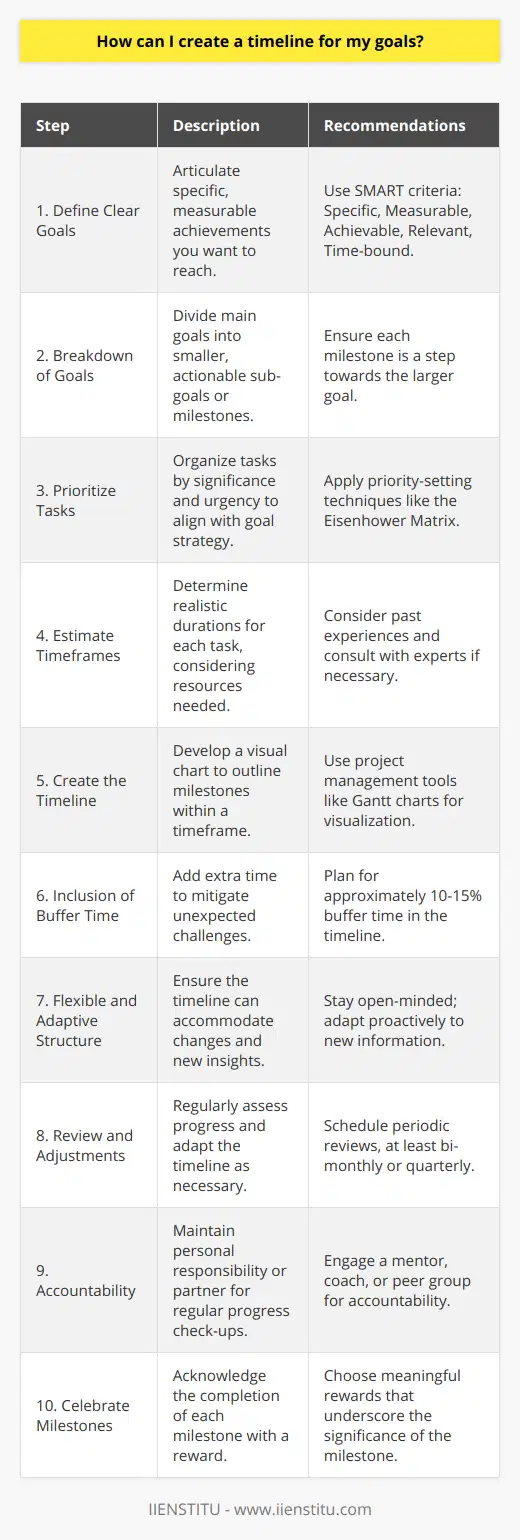
What are some best practices for staying motivated and on track with goal setting?
Personal development courses at IIENSTITU can provide the guidance and support you need to stay motivated and on track toward reaching your goals. Through interactive lectures, workshops, and exercises, these courses will help equip you with the necessary knowledge and skills for successful goal setting.
In addition, by being part of a supportive learning community focused on personal development, you'll have access to valuable resources, such as mentorships from experienced professionals who can give helpful advice on how to reach your dreams. With personalized guidance and accessible learning materials tailored to individual needs, personal development courses at IIENSTITU are an excellent way to set yourself up for success!

What is the importance of goal setting?
Goal setting is an essential first step for any personal development plan. It helps to create structure and focus, giving you the direction and motivation you need to pursue your dreams.
Breaking down goals into smaller steps allows you to track progress and quickly stay on track toward completion.
Additionally, a support system can help keep motivation high while encouraging when needed.
Finally, celebrating successes along the way makes the journey enjoyable and rewarding. Goal setting is essential in any personal development plan and can help ensure success!
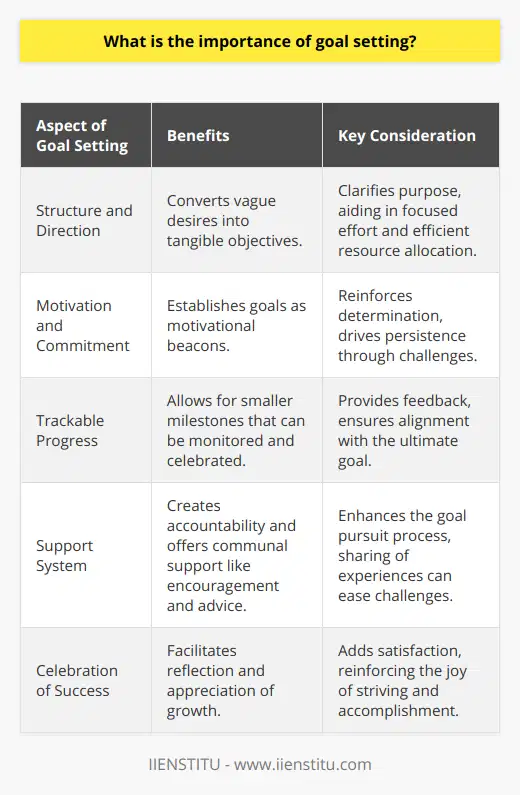
What are the key components of an effective personal development plan?
Introduction
Personal development plans are frameworks for ongoing self-improvement and professional growth, essential for individuals seeking to build a successful career. To be effective, these plans must incorporate certain key components.
Goal Setting and Prioritization
A critical aspect of a personal development plan is the identification of clear, specific, and measurable goals. These objectives should reflect an individual's priorities and aspirations, addressing both short-term milestones and long-term ambitions. Prioritization of goals helps to allocate time, effort, and resources efficiently, enabling a focused approach to development.
Skills Assessment and Gap Analysis
An accurate assessment of one's current abilities, knowledge, and expertise is essential to identify areas for improvement. Skills assessment entails a comprehensive analysis of existing competencies, while gap analysis measures the difference between current abilities and those required for achieving goals. Recognizing these gaps aids the development of targeted strategies for growth and learning.
Action Plan and Timeline
Once goals are set and skill gaps identified, an effective personal development plan must incorporate a well-structured action plan. This includes outlining specific steps, activities, and resources essential for achieving objectives. Additionally, establishing a realistic timeline ensures progress is measurable, maintains motivation, and allows for the adjustment of strategies as needed.
Accountability and Support
Monitoring progress and holding oneself accountable is crucial for successful personal development. Regular self-reflection and evaluation of progress against set goals helps to maintain motivation, measure success, and identify areas requiring adjustment. Furthermore, seeking guidance and support from mentors, peers, and other professionals can enhance learning experiences and facilitate growth.
Continuous Learning and Adaptability
An effective personal development plan must recognize that growth is an ongoing process. Embracing a mindset of continuous learning and adaptability to change is key to staying relevant in an ever-evolving professional landscape. Accordingly, individuals should regularly update their development plans to reflect new goals, skill requirements, and learning opportunities.
Conclusion
In summary, the key components of an effective personal development plan include goal setting and prioritization, skills assessment and gap analysis, a detailed action plan with a timeline, accountability mechanisms, and a commitment to continuous learning and adaptability. When well-implemented, these elements work together to facilitate personal and professional growth, preparing individuals for success in their chosen career paths.
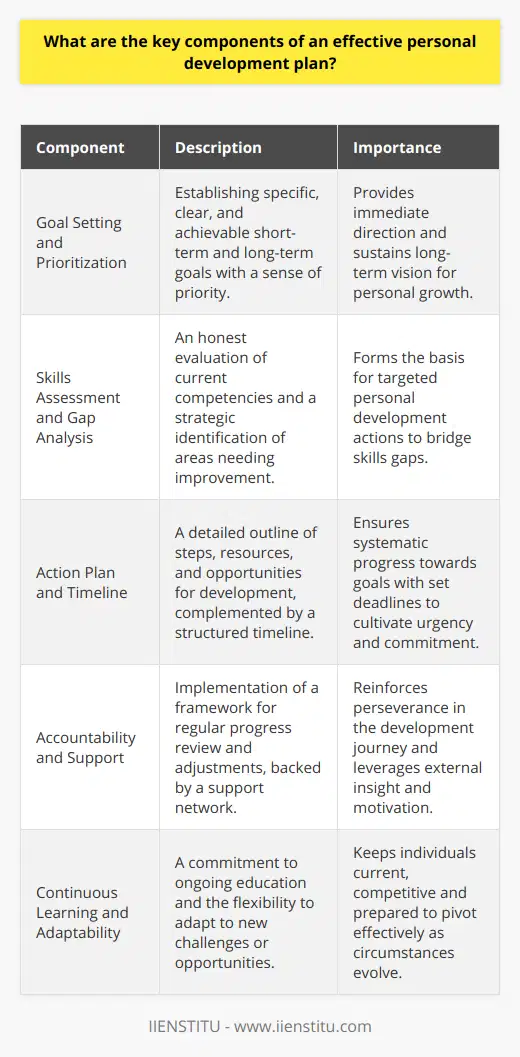
What strategies can help individuals stay consistent and committed to their personal development goals?
Establishing Clear Goals
To stay consistent and committed to personal development goals, individuals should first establish clear and specific objectives. It is essential to identify areas needing improvement, break them down into smaller, manageable tasks, and set deadlines for achieving each milestone. Utilizing the SMART (Specific, Measurable, Achievable, Relevant, Time-bound) framework can be particularly helpful in this process.
Creating Daily Habits
Incorporating daily habits that align with personal development goals can foster consistency and commitment. Daily practices, such as journaling or practicing mindfulness, can yield substantial benefits over time. In addition, setting aside time for personal growth activities each day, such as reading or engaging in professional development courses, can help maintain focus on goals.
Utilizing Accountability Mechanisms
Accountability mechanisms, such as sharing goals with friends, family members, or colleagues, can bolster commitment to personal development. Besides, individuals could consider joining supportive communities or groups that share similar development objectives. Reporting progress and receiving constructive feedback from others can effectively reinforce motivation and persistence.
Adapting a Growth Mindset
Cultivating a growth mindset - the belief that skills and abilities can improve through dedicated effort - can significantly influence an individual's commitment to personal development. Embracing challenges, treating setbacks as learning opportunities, and persistently seeking self-improvement can help maintain consistency and momentum in the pursuit of personal goals.
Setting Realistic Expectations
Finally, setting realistic expectations for personal development can prevent feelings of discouragement or failure, which could potentially undermine the progress achieved. Recognizing that growth is a continuous and non-linear process helps maintain a long-term perspective and allows individuals to celebrate small victories along the journey.
In conclusion, strategies such as establishing clear goals, creating daily habits, utilizing accountability mechanisms, adapting a growth mindset, and setting realistic expectations can effectively help individuals stay committed to their personal development goals. These approaches, when combined, can facilitate a consistent focus on self-improvement and ultimately lead to meaningful growth and transformation.

How can one measure progress and success in their personal growth journey?
**Defining Personal Growth Progress and Success**
In order to measure progress and success in one's personal growth journey, it is crucial to first define what personal growth entails. Personal growth can encompass various aspects of an individual's life, such as emotional, intellectual, social, and professional development. By identifying specific goals and values within these areas, an individual can better assess their progress and success.
**Set Clear Goals and Benchmarks**
A measurable approach to evaluating progress and success involves setting clear and attainable objectives in areas of personal growth. Establishing concrete goals with deadlines allows one to track their advancement towards achieving them. By breaking larger objectives into smaller, actionable steps or benchmarks, individuals can frequently assess their development and determine how successfully they are reaching their targets.
**Self-Reflection and Journaling**
Regular self-reflection and journaling can provide valuable insight into one's personal growth journey. Reflecting on one's feelings, thoughts, actions, and experiences can help identify patterns and areas for improvement. By documenting and analyzing this personal data, individuals can gauge their progress and celebrate their achievements, as well as identify areas where additional attention or effort may be needed.
**Collect Feedback from Others**
Another way to measure progress and success is by seeking feedback from others. Engaging with trusted friends, family members, mentors, or colleagues for constructive criticism and support can provide a different perspective on one's growth. This third-party input can offer new insights, highlight accomplishments, and identify blind spots in one's development, thus helping evaluate their progress more accurately.
**Establishing Personal Metrics**
Developing a set of personal performance metrics can be an effective way to quantitatively measure personal growth success. Various self-assessment tools, ranging from questionnaires, psychological tests, or online tracking applications, can help individuals gauge their progress in areas like emotional intelligence, communication skills, or time management. By regularly assessing personal metrics, individuals can quickly identify areas of growth and areas that need improvement.
In conclusion, measuring progress and success in one's personal growth journey involves a multi-faceted approach. This includes setting clear goals and benchmarks, engaging in regular self-reflection and journaling, seeking feedback from others, and establishing personal metrics. By utilizing these techniques, individuals can effectively track their development and accomplishments, ensuring they remain on track to achieve their personal growth objectives.
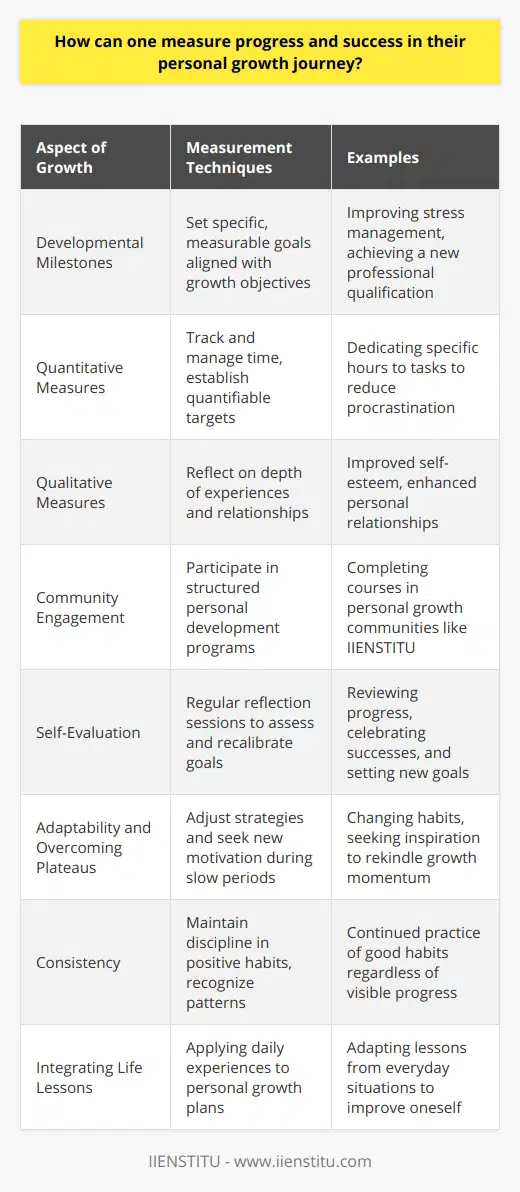
What elements are essential for crafting a comprehensive personal development plan for 2023?
Setting Clear Goals
A comprehensive personal development plan for 2023 requires several critical elements, starting with setting clear and specific goals. These objectives should align with one's personal values, strengths, and aspirations. Additionally, incorporating measurable milestones facilitates tracking progress and maintaining motivation throughout the year.
Identifying Required Resources
Next, it is crucial to identify the necessary resources that will support personal growth and the achievement of set goals. These resources may include books, mentors, online courses, or workshops that provide information, guidance, and inspiration. Further, recognizing and addressing potential obstacles, such as time constraints or financial limitations, is vital for successful personal development planning.
Developing an Action Plan
Developing a practical and achievable action plan is another essential element. This includes outlining tangible steps to reach goals and designating reasonable deadlines for each step. Regularly reflecting on accomplishments and adapting the plan as needed will ensure the relevance and effectiveness of the chosen strategies.
Creating a Support System
To enhance the likelihood of success, it is crucial to cultivate a strong support system that consists of encouraging friends, family members, or mentors. This circle can offer constructive feedback, emotional support, and accountability during the personal development journey. Sharing goals and milestones with supportive individuals can increase motivation and foster a sense of commitment.
Practicing Self-Reflection
Finally, the inclusion of self-reflection in a personal development plan is vital. Periodically evaluating progress, adjusting strategies, and celebrating accomplishments fosters continuous improvement and self-awareness. By taking the time to reflect on one's experiences, it becomes possible to learn from successes and setbacks, refining the plan for optimal growth.
In conclusion, crafting a comprehensive personal development plan for 2023 requires setting clear goals, identifying required resources, developing a practical action plan, creating a support system, and practicing self-reflection. By considering these fundamental elements, individuals are more likely to achieve meaningful progress and personal growth in the coming year.
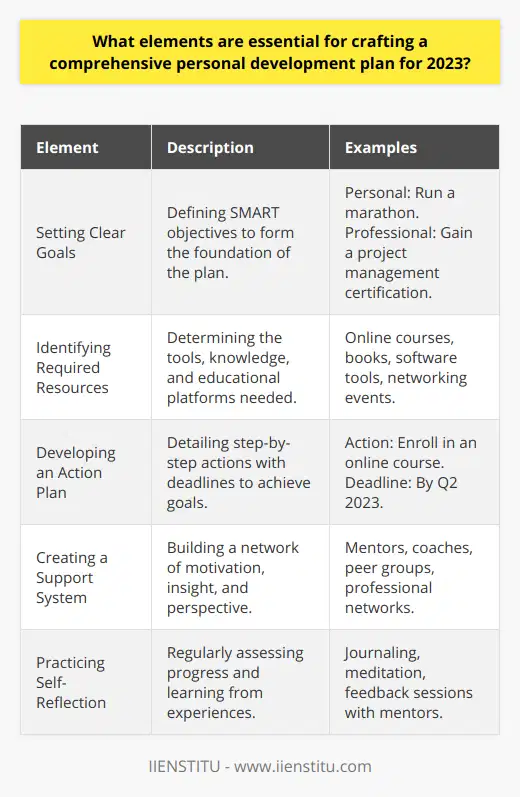
How can the SMART criteria be applied to enhance the effectiveness of a personal development plan?
Integrating SMART Criteria in Personal Development Plans
An effective way to enhance a personal development plan (PDP) is by incorporating the SMART (Specific, Measurable, Achievable, Relevant, Time-bound) criteria. This widely accepted framework can improve the PDP's effectiveness by helping individuals set clear goals, monitor progress, and attain desired outcomes.
Specific Goals
To begin with, SMART criteria demand that goals set within a PDP are specific. This means clearly defining what one wants to achieve, thus avoiding ambiguity. A well-articulated goal guides individuals to develop focused strategies and prevent wasted time or resources on unrelated activities.
Measurable Outcomes
Next, for a PDP to be effective, it is essential to identify measurable outcomes for each goal. This involves determining quantifiable metrics or qualitative indicators that will help assess progress. By assigning criteria for success, individuals can analyze their accomplishments and adjust their approach accordingly.
Achievable Objectives
Moreover, SMART objectives call for achievable goals. Setting unattainable targets may lead to frustration and loss of motivation. Adopting a realistic approach enables individuals to maintain their drive, recognize potential obstacles, and develop strategies to overcome them. Consequently, this increases the likelihood of success.
Relevant Ambitions
Another aspect of SMART criteria is targeting relevant goals. When setting objectives within a PDP, it is crucial to consider their alignment with one's long-term vision, interests, and values. Pursuing relevant ambitions ensures individuals remain engaged, committed, and willing to invest time and effort in their personal growth.
Time-bound Plans
Finally, SMART criteria encourage setting time-bound goals. This involves establishing deadlines or timeframes for achieving the desired outcomes. A well-defined timeline adds a sense of urgency, promoting effective time management and prioritization of tasks. Additionally, having a specific endpoint allows for regular reevaluation of progress and, if necessary, adjustment of goals or strategies.
In conclusion, integrating SMART criteria into a personal development plan significantly enhances its effectiveness. By establishing specific, measurable, achievable, relevant, and time-bound targets, individuals can set a clear roadmap for growth, develop a focused approach to achieving their goals, and increase their chances of success.
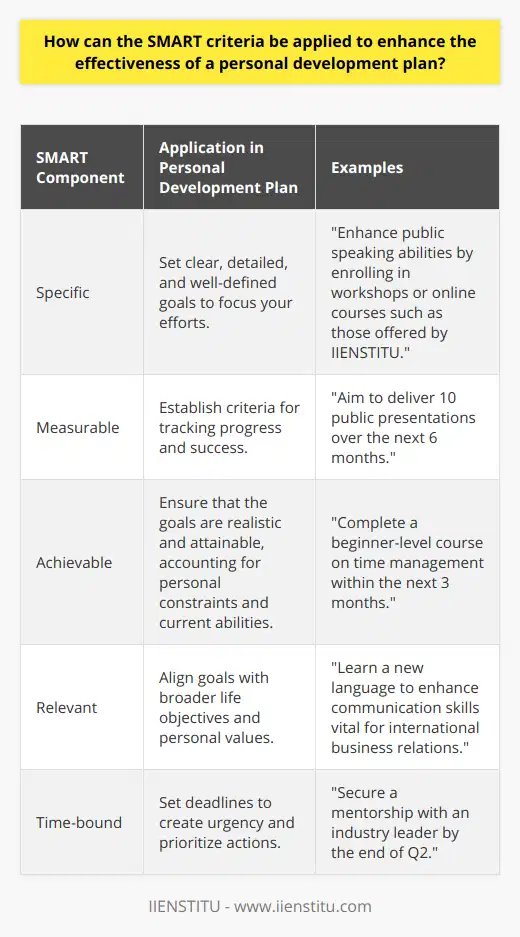
What approaches can be taken to regularly review and adjust a personal development plan to ensure continued growth and improvement?
Constant Self-Evaluation
One approach to regularly review and adjust a personal development plan is by engaging in constant self-evaluation. This involves assessing one's progress towards set goals and objectives, as well as identifying areas that need improvement.
Goal Reassessment
Another approach is goal reassessment, which entails revisiting and adjusting one's goals and objectives in light of new experiences, knowledge, or changes in personal circumstances. This process ensures that personal development plans remain relevant and effective as individuals evolve.
Seeking Feedback
A crucial aspect of maintaining personal growth and improvement is seeking feedback from others. By gathering input from mentors, colleagues, and peers, individuals gain valuable insights into their strengths and weaknesses. This allows for more targeted improvement efforts that can enhance personal growth and development.
Adjustment of Strategies
As individuals gain new knowledge or experiences, it may become clear that certain strategies implemented in their personal development plan are no longer effective in promoting growth. In such instances, it is essential to adjust these strategies or implement new ones that cater better to their needs and circumstances.
Periodic Review and Reflection
In order to ensure continued growth and improvement, individuals should allocate time for periodic review and reflection on their personal development plan. This involves analyzing progress towards goals, assessing growth, and determining future objectives.
Monitor Progress
Monitoring progress is a critical aspect of maintaining focus and motivation in continuous growth and improvement. By consistently tracking achievements and comparing them to original objectives, individuals can determine whether they are on track to meet their goals or if adjustments are necessary to achieve desired outcomes.
In conclusion, regular review and adjustment of a personal development plan are essential to maintaining consistent growth and improvement. This can be achieved through constant self-evaluation, goal reassessment, seeking feedback, adjusting strategies, allocating time for periodic review and reflection, as well as monitoring progress. By adhering to these approaches, individuals can ensure that their personal development plan remains relevant, efficient, and ultimately successful.
